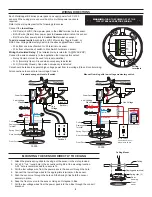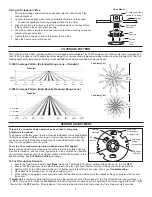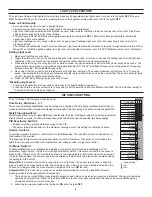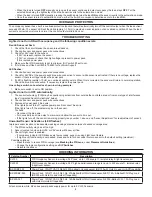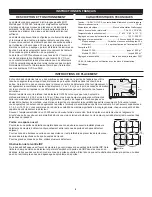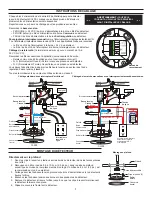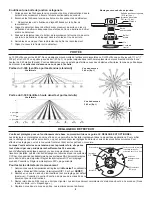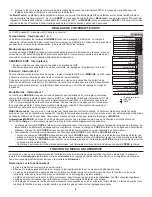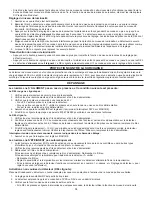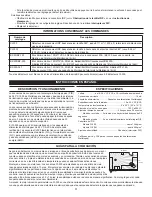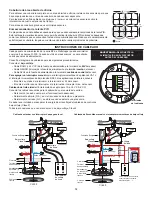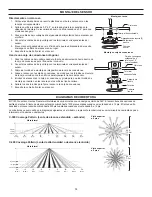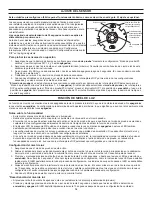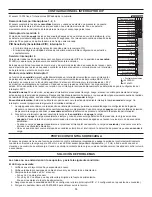
3
COVERAGE PATTERN
The CI-300 provides a 360° coverage pattern. Two lens patterns are available. The CI-300 provides up to 1200 square feet of coverage and
the CI-300-1 provides up to 500 square feet of coverage. The coverage shown represents walking motion at a mounting height of 8 feet. For
building spaces with lower levels of activity or with obstacles and barriers, coverage size may decrease.
8’ (2.4m)
10’ (3m)
12’ (3.7m)
0
40’
(12.2m)
30’
(9.1m)
20’
(6.1m)
10’
(3m)
40’
(12.2m)
30’
(9.1m)
20’
(6.1m)
10’
(3m)
0
8’ (2.4m)
10’ (3m)
12’ (3.7m)
0
20’
(6.1m)
15’
(4.6m)
10’
(3m)
5’
(1.5m)
0
20’
(6.1m)
15’
(4.6m)
10’
(3m)
5’
(1.5m)
24 ft
7.3m
IW
P
Top View @ 8ft
Top View @ 8ft
C-300 Coverage Pattern (Extended Range Lens – Standard)
C-300 Coverage Pattern (High Density Reduced Range Lens)
Side View
Side View
Using an Octagonal J-Box
1. Pull the low voltage wires from the power pack into the J-Box through the
conduit knockout.
2. Connect the low voltage wires to the appropriate terminals on the sensor.
3. Loosen the appliance mounting screws attached to the J-Box
4. Align the sensor in the J-Box so that the mounting screws on the box match
the key holes on the sensor’s rear housing.
5. Push the sensor up into the J -Box and twist it so that the mounting screws are
seated in the keyhole slots.
6. Tighten the two screws to secure the sensor to the J-Box.
7. Snap the front cover onto the sensor.
Rear
Housing
Depluggable
Terminal
4" Octagonal J-Box
(at least 1.5" deep)
Front
Cover
Ceiling
Screws
J-Box Mount
SENSOR ADJUSTMENT
This unit is pre-set for basic operation as described in this guide.
Adjustment is optional.
The sensors are factory preset to allow for quick installation in most applications.
Verification of proper wiring or coverage, or customizing the sensor’s settings
can be done using the following procedures. To make adjustments, open the
Front Cover by pulling on the cover tab.
There is a 30 second warm-up period when power is first applied.
Before making adjustments, make sure the office furniture is installed, lighting
circuits are turned on, and the HVAC systems are in the overridden/on position.
VAV systems should be set to their highest airflow. Set the DIP switches to the
desired settings. See
DIP Switch Setting
, next page.
To Test Occupancy Sensors
1. Ensure the Time Delay is set for
Test Mode*
using the “Test Mode/20 minutes” setting. (DIP switches 1,2, & 3 are
OFF
).
2. Ensure that the Light Level is at default (maximum). See the Light Level Feature section of this document for instructions.
3. Remain still. The red LED should not flash. The lights should turn off after 5 seconds. (If not, see
Troubleshooting
.)
4. Move about the coverage area. The lights should come on.
5. When testing and adjustment are complete, reset DIP Switches and Light Level to the desired settings, and replace the cover on
the sensor.
* Test Mode
is a temporary state that starts when you first set the sensor’s DIP switches for the “Test Mode/20 minutes” (switches 1, 2,
3,
OFF
). If you need to invoke the
Test Mode
and the DIP switches are already set for Test Mode/20 minutes, toggle DIP switch 1
ON
then back to the
OFF
position. This provides a 10 minute test period. During the test period, the Time Delay is only 5 seconds.
.H\KROHVORWV
IRUPRXQWLQJWR
RFWDJRQDOER[
'RXEOHJDQJ
PXGULQJ
PRXQWLQJKROHV
/LJKWOHYHO
SXVKEXWWRQ
',3
VZLWFKHV
3,5OHQV
21
(&(
3,5$FWLYLW\
/('5HG


